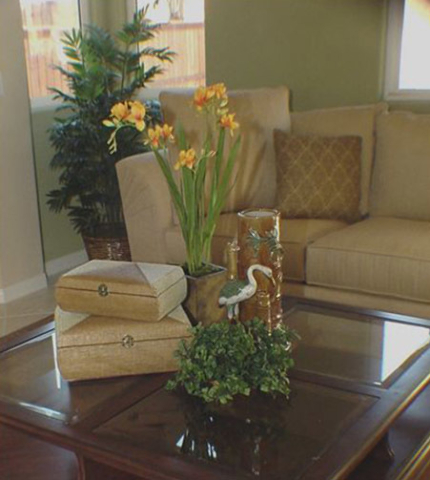Accessories can pull room together
This month I’d like to finish what became a series on redesigning a room. The last step is accessorizing, which, besides selecting paint colors, seems to be the most frustrating area for most homeowners.
Accessories are the finishing touches that make your home personal and bring each room together, just as jewelry shows your personality and dresses up your wardrobe. They both complete and complement your foundation.
Accessorizing is about fussing with things until they feel right, which I know is where some of the challenge comes from. To start, clear off your coffee table; it’s important to start when a blank canvas.
Next gather up the accessories that you would like to use, knowing you’re not going to use all of them. Group them by type just like you see in the store: candles, vases, figurines, boxes, greenery and frames.
What you’re going to do is form a triangular pattern that has three layers or heights, and a variety of textures and color. Although you can create a stunning grouping with all the same textures and colors, you still need to vary the heights.
Start with your tallest accessory and place it off-center and to the back of the table, instead of right in the middle. You want to create a grouping versus lining them up.
Now select the next one you would like to use that is smaller and place it at the second point of the triangle. Then the third, which will be your smallest. Many times my third accessory is greenery to soften the grouping.
If you have a large table or would like more than three, place two more items into your triangular pattern. I do like using odd numbers, but nothing says you have to. It’s all about balance, and once you’re comfortable creating groupings, do what looks and feels right.
If you need a starting point, take pictures at model homes, look online or cut from magazines. Then re-create by selecting similar accessories from what you have.
I know this sounds simple, but always isn’t when you start, so here are a couple things to watch for.
Make sure nothing is too high and blocking your view to the television or chairs where guest may be sitting. You don’t want to have to look around candlesticks to watch television or chat.
How does your grouping look from all angles? I don’t like using frames on a coffee table because you see the backs when sitting on the sofa. They are best placed on side tables or a console.
Don’t overcrowd the table. This is sometimes where people go astray, and it ends up looking like a sale table. Add one piece at a time, and when it looks too crowded, take the last one off.
Are the accessories visually too heavy, too light or too large or too small for the table? You especially need to watch this when you have a small, delicate glass table. But on the same token, a large wood table should have substantial pieces.
Keep the theme the same. I wouldn’t place a rustic candlestick with an Oriental vase.
Have you added color? It can be as simple as color from candles, decorative balls, potpourri, flowers or even books.
You would follow the same steps for your side and console table, but your lamp can count as one of your accessories.
On your mantel, your fireplace and artwork are your focal points. So here less is more. Don’t let your accessories take center stage.
Instead, flank your artwork with them. Go for an asymmetrical arrangement, but if you’re having trouble with it, there’s nothing wrong with symmetry.
In your bookcases and china hutches, please try and not have them become storage. There’s something about those horizontal shelves that just attract way too much.
When placing your accessories, zigzag the groupings from corner to corner as you move from shelf to shelf versus everything straight across. It’s always best that your eye has someplace to rest to appreciate your beautiful things.
Accessorizing really is the fun part and makes all the difference in a well-made room. Don’t be afraid to try difference arrangements. That’s the best part of redesign; it doesn’t cost anything to move things around.
Gail Mayhugh, owner of GMJ Interiors, is a professional interior designer and author of a book on the subject. Questions may be sent by email to: GMJinteriors@gmail.com. Or, mail to: 7380 S. Eastern Ave., No. 124-272, Las Vegas, NV 89123. Her Web address is: www.GMJinteriors.com.




























